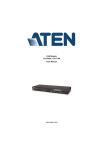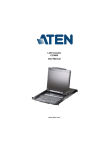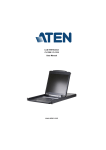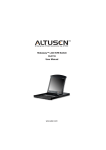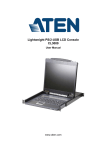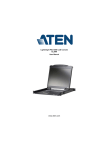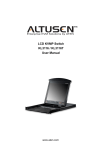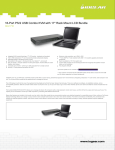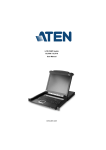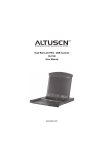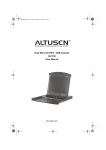Download iogear GCS1716KIT KVM switch
Transcript
Installation Guide 16-Port USB PS/2 Combo KVM Switch 1 GCS1716 PART NO. M1074 ©2008 IOGEAR. All Rights Reserved. PKG-M1074 IOGEAR, the IOGEAR logo, MiniView®, VSE are trademarks or registered trademarks of IOGEAR, Inc. Microsoft and Windows are registered trademarks of Microsoft Corporation. IBM is a registered trademark of International Business Machines, Inc. Macintosh, G3/G4 and iMac are registered trademarks of Apple Computer, Inc. IOGEAR makes no warranty of any kind with regards to the information presented in this document. All information furnished here is for informational purposes only and is subject to change without notice. IOGEAR, Inc. assumes no responsibility for any inaccuracies or errors that may appear in this document. 2 Table of Contents Firmware Upgrade Utility 67 5 Limited Warrany 74 7 Federal Communications Commission (FCC) Statement 75 Contact 76 Technical Support 77 Specifications 79 Troubleshooting 85 Appendix 86 Package Contents 4 Requirements Product Overview Features 8 Hardware overview 10 Hardware Setup 15 Basic Operation 28 OSD Operation 32 Keyboard Port Operation 51 Keybard Emulation 63 3 Package Contents –– –– –– –– –– –– –– –– –– –– –– 1 x GCS1716 16-Port KVM Switch with Standard Rack Mounting Kit 2 x Custom KVM cable sets (1 USB and 1 PS/2) 1 x Console cable 1 x Cascading cable 1 x Firmware Upgrade cable* 1 x Grounding wire 1 x Foot Pad set (4 pads) 1 x Power Adapter 1 x User Manual** 1 x Quick Start Guide 1 x Warranty Registration Form Check to make sure that all the components are present and that nothing got damaged in shipping. If you encounter a problem, contact your dealer. Read this manual thoroughly and follow the installation and operation procedures carefully to prevent any damage to the unit, and/or any of the devices connected to it. * Upgraded firmware may have been developed since you last purchased the product. Please visit our website to check and download the latest firmware version. ** Features may have been added to the GCS1716 since this manual was printed. Please visit our website to download the most up-to-date version of the manual. 4 Requirements Console The following hardware components are required for the KVM console: –– A VGA, SVGA, or multisync monitor capable of displaying the highest resolution provided by any computer in the installation. –– A keyboard and mouse (USB or PS/2) Computers The following hardware components are required for each computer: –– A VGA, SVGA, or multisync video graphics card with an HDB-15 port. –– PS/2 mouse and keyboard ports (6-pin mini-DIN), at least one USB port. Cables Sub-standard cables might damage the connected devices or degrade overall performance. For optimum signal integrity and to simplify the layout, use the high quality IOGEAR custom cable sets described below. Function KVM switch to computer (or to another switch if cascading) connection 5 Length Part Number PS/2 6 ft 10 ft 20 ft G2L-5202P G2L-5203P G2L-5206P USB 6 ft 10 ft 16 ft G2L-5202U G2L-5203U G2L-5205U Operating Systems Supported operating systems are shown in the table, below: OS Version Windows Linux 2000 or higher, XP, Vista RedHat 7.1 or higher, Fedora Core 2, Fedora Core 3, Fedora Core 4 SuSE 8.2, 9.3, 10 Mandriva (Mandrake) 9.0 6 Product Overview The GCS1716 KVM switch allows access and control up to 256 computers from a single console (keyboard, mouse, and monitor). As many as 16 additional switches can be cascaded bringing the total number of connected computers to 256 computers that can be controlled from a single keyboard-monitor-mouse console. Additionally, the GCS1716 features high density SPHD 15-pin instead of the usual 25-pin connectors thus allowing for a compact design and installation in a 1U system rack. The GCS1716 includes one USB port located on the front panel for easy access and sharing of any USB peripherals. Setup is fast and easy; plugging cables into their appropriate ports is all that is needed. The switch supports both USB and PS/2 connections for the console and computers. The GCS1716 intercepts keyboard input directly, thus eliminating the need for any software configuration. Switching between computers can be easily accomplished either by manually pressing the front panel push button port LEDs, entering hotkey combinations from the keyboard, or via a menu driven multilingual on-screen display (OSD) system. A convenient auto-scan feature permits automatic scanning and monitoring of activities on all connected. Lastly, the GCS1716 offers benefits such as: a) managing multiple computers from a single console, b) eliminating the expense of having to purchase a separate keyboard, monitor, and mouse for each computer, c) space and energy costs savings, and d) helping create a greener environment by reducing amount of waste. 7 Features • A single console controls up to 256 computers • Cascade to 2 levels – connect up to 16 switches • Front panel USB port allows each computer to access USB peripherals* • Dual Interface – supports computers with PS/2 or USB keyboards and mice • Multiplatform support – Windows 2000/XP/Vista, Linux, Mac, and Sun • Supports multimedia USB keyboards for PC, Mac and Sun • Auto PS/2 and USB interface detection • USB or PS/2 keyboard and mouse emulation – computers boot even when the console focus is elsewhere • Superior video quality – up to 2048 x 1536; DDC2B • Display Emulation Technology – stores the console monitor’s EDID (Extended Display Identification Data) to optimize display resolution • Convenient computer switching via front panel pushbuttons, hotkeys, or multilingual on-screen display (OSD) menu • Two level password security - only authorized users view and control computers; up to four users and 8 an administrator with a separate profile for each • Auto Scan feature for monitoring user-selected computers • Broadcast mode – operations simultaneously performed on all selected computers • Hot pluggable – add or remove computers without having to power down the switch • Buzzer on/off via hotkey and OSD • Firmware upgradeable • No software installation required • Designed for desktop or rack mount (19” system rack, 1U) * The USB peripheral function only works with USB cable set connections. It will not work with PS/2 cable set connections. 9 Hardware Overview Front view 1 2 3 4 5 10 6 No. Component Description 1 Port LED’s These port selection push buttons each contain 2 LEDs. • An orange LED indicates that a computer is connected to the corresponding port. • A green LED indicates that the computer connected to the corresponding port has focus. • Simultaneously pressing port LEDs 1 & 2 resets the console keyboard and mouse. • Simultaneously pressing port LEDs 15 & 16 on the GCS1716 starts Auto Scan mode. See F7: SCAN 2 Reset Button Pressing this button performs a system reset. When the system is reset, the GCS1716 beeps, and then the KVM port LEDs flash in succession until the reset is completed. After the reset is complete, you can login again. Note: This button is semi-recessed and must be pushed with a small object, such as the end of a paper clip or a thin ballpoint pen. 3 USB Port USB peripherals (flash drive, CD-ROM, etc.) plug into this port. 11 No. Component Description 4 Firmware Upgrade Recovery Switch During normal operation and while performing a firmware upgrade, this switch should be in the NORMAL position. If a firmware upgrade operation does not complete successfully, this switch is used to perform a firmware upgrade recovery 5 Firmware Upgrade Port The firmware upgrade cable that transfers the firmware upgrade data from the administrator’s computer to the GCS1716, plugs into this RJ-11 connector. 6 Power LED Lights green to indicate that the unit is receiving power. 12 Back view 1 18 17 16 15 14 13 12 11 8 7 6 5 4 3 2 1 CONSOLE 2 3 4 PS/2-USB 5 13 CPU No Components Description 1 KVM Ports The cables that link to the computers plug in here. Note: The shape of these 15-pin connectors has been specifically modified so that only custom KVM cables designed to work with this switch can be plugged in. Do NOT attempt to use ordinary 15-pin VGA connector cables to link these ports to the computers. 2 Grounding Terminal The grounding wire used to ground the GCS1716 attaches here. 3 Cable Tie Slot If you want to use a cable tie to gather the cables together, you can run it through this slot to attach it to the unit. 4 Power Jack The power adapter cable plugs in here. 5 Console Port The custom console cable set that is provided to attach the console monitor, keyboard, and mouse plugs in here. 14 Hardware Setup Overview The GCS1716 is a combo switch designed to work with USB and PS/2 interfaces. It utilizes custom KVM cables that serve as intermediaries between the switch and the connected computers. A separate custom KVM cable is required for each computer connection. Custom cables of various lengths are listed in the Cables section on page 5. Consult your dealer to find out which one fit your needs best. Before You Begin Make sure that the power to any device that you connect has been turned off. You must unplug the power cords of any computers that have the Keyboard Power On function. Stacking and Rack Mounting The GCS1716 can be stacked on a desktop or rack mounted by a variety of different methods in 1U of rack space. The procedures for each method are described in the following sections. Note: 1. Allow at least 2 in (5.1 cm) on each side for adequate ventilation and 5 in (12.7 cm) at the rear for power cord and cable clearance. 2. The standard rack mounting kit does not include screws or cage nuts. If you need additional screws or cage nuts, contact your rack dealer. 15 Stacking The GCS1716 can be placed on any level surface that can safely support its weight and the weight of the attached cables. Ensure that the surface is clean and free of materials that can block the exhaust vents or otherwise interfere with the switch normal operation. Peel the protective film off of the foot pads, and affix the pads to the bottom panel at the corners, as shown in the diagram below. 16 Rack Mounting 1. Remove the screws from the left and right sides of the switch (2 screws total) near the front of the switch. 17 2. Use the M3 x 8 Phillips hex head screws supplied with the rack mounting kit to screw the rack mounting brackets into the sides near the front of the unit. 18 3. Place the KVM switch in the rack. Position it so that the holes in the mounting brackets line up with the holes in the rack. Secure the mounting brackets to the front of the rack. 19 Grounding To prevent damaging your equipment, it is important that all devices are properly grounded. Use the included grounding wire to ground the KVM switch by connecting one end of the wire to the grounding terminal, and the other end of the wire to a suitable grounded object. 18 17 16 15 14 13 12 11 8 7 6 5 4 3 2 1 CONSOLE PS/2-USB 20 CPU Single Level Installation In a single level installation, only one switch is utilized. To set up, do the following: 1. Make sure that that switch is grounded and power has been turned off to all the computers you will be connecting. 2. Using the console cable provided, connect a keyboard, mouse, and monitor to the console port. Refer to the Cable Connection Diagrams on the following page. 18 17 16 15 14 13 12 11 8 7 6 5 4 3 2 1 CONSOLE 1 PS/2-USB 2 21 CPU 3. Using a KVM cable connect it an available KVM port on the GCS1716. Make sure to connect the keyboard, video and mouse ports to the computer you are installing. Refer to the KVM Cable Installation Diagrams on the following page. Note: in order to use the peripheral USB port on the KVM you will need to use a USB KVM cable on the GCS1716 and connect it to your computer. 4. Plug the power adapter cable into the power jack and into an AC power source. 5. Turn on the power to the computers. 5 ................................................ 3 18 17 16 15 14 13 12 11 8 7 6 5 4 3 2 1 CONSOLE 1 PS/2-USB CPU 2 4 .................................... . . . . . . . . . . . . 22 Two Levels Installation (Cascading) Note: The cascading feature will only be available on products that will ship after January 2009. If you purchased a GCS1716 prior to January 2009, you can add the cascading feature by simply upgrading the Firmware. Visit www.iogear.com/support for the latest updates. To control more computers, up to 16 additional switches can be cascaded down from the first GCS1716. As many as 256 computers can be controlled from a single console in a complete installation. Note: It is recommended to use the USB KVM custom cable rather than the PS/2 one for cascading application (see Cables Table, page 5). To set up a cascading installation, follow the steps below: 1. Make sure that that switch is grounded and power has been turned off to all components you will be using. 2. Using the console cable provided, connect a keyboard, mouse, and monitor to the console port on the KVM. Refer to the Cable Connection Diagrams on page 25. 23 3. Using a cascading cable, connect the available CPU port on the upper level GCS1716, to the console port on the lower level GCS1716. Refer to the diagram on page 27. 4. Repeat the above step #3 for any additional switches you wish to add by connecting the second unit to another available CPU port on the first GCS1716. 5. The Power On sequence requires that all second stage units be powered on first. After they are all on, the first stage units must be powered on next. Only after all the switches have been powered on in this sequence, can the computers be powered on. 24 Console Cable Installation Diagram 18 17 16 15 14 13 12 11 8 7 6 5 4 3 2 1 CONSOLE USB VGA PS/2-USB PS/2 25 CPU KVM Cable Installation Diagrams USB KVM Cable Connection PS/2 KVM Cable Connection 26 Cascading Installation Diagram 18 17 16 15 14 13 12 11 8 7 6 5 4 3 2 1 CONSOLE CPU PS/2-USB 18 17 16 15 14 13 12 11 8 7 6 5 4 3 2 1 CONSOLE PS/2-USB 27 CPU Basic Operation Hot Plugging The GCS1716 supports hot plugging – components can be removed and added back into the installation by unplugging their cables from the ports without the need to shut the unit down. However, in order for hot plugging to work properly, the procedures described below must be followed: Hot Plugging KVM Ports In order for the OSD menu to correspond to the KVM port changes, you must manually reconfigure the OSD to reflect the new port information. Note: If the computer’s operating system does not support hot plugging, this function may not work properly. 28 Hot Plugging Console Ports The keyboard, monitor, and mouse can all be hot plugged. When hot plugging the mouse: • You may unplug and re-plug it as long as you use the same mouse. • If you plug in a different mouse, all the computers on the installation must be shut down for 10 seconds, then restarted following the power up sequence Note: If after hot plugging there is no response to the keyboard and/or mouse input, perform a Keyboard and Mouse Reset by simultaneously pressing the 1 and 2 front panel port LEDs. Port Selection The GCS1716 provides three port selection methods to access the computers on the installation: 1) Manual, 2) An On-Screen Display (OSD) menu system, and 3) Hotkeys. 29 Manual Port Switching Use the front panel push button switches to manually switch to a port. Powering Off and Restarting If it becomes necessary to power off a GCS1716, do the following before restarting it: 1. Unplug the unit from its power source. 2. Shut down all the computers that are attached to it. Note: Unplug the power cords of any computers that have the Keyboard Power On function. Otherwise, the GCS1716 will still receive power from the computers. 3. Wait 10 seconds, then plug the KVM back in. 4. Power on the computers. Note: If there are stations cascaded down from it, all the cascaded stations and the computers attached to them must be shut down as well. 30 USB Peripheral Devices The front panel USB port is available to connect a USB peripheral device such as a flash drive, CD-ROM drive, printer, etc. Any computer connected to the GCS1716 can access the USB peripheral on a one at-a-time basis. The peripheral device is available to computers connected to the GCS1716 on the same level only, and is not available to computers connected to cascading switches. The USB peripheral device is automatically detected on the target computer when switching ports. For example, when switching from a computer connected to port 1 to a computer connected to port 2, the peripheral device automatically disconnects from the computer on port 1 and connects to the computer on port 2. 31 OSD Operation OSD Overview The On-Screen Display (OSD) is a mouse and keyboard enabled menu driven method to handle computer control and switching operations. All procedures start from the OSD main screen. OSD Login The OSD incorporates a two level (administrator / user) password system. Before the OSD main screen displays, a login screen appears requiring a password. If this is the first time that the OSD is used, or if the password function has not been set, simply press [Enter]. The OSD main screen displays in administrator mode. In this mode, you have administrator privileges with access to all administrator and user functions, and can set up operations (including password authorization) as you like. If the password function has been set, you must provide an appropriate administrator/user password in order to access the OSD. OSD Hotkey You can display the OSD on the console monitor while also viewing the display of any port on the GCS1716 by pressing the [Scroll Lock] key twice. Note: You can optionally change the OSD hotkey to the Ctrl key, in which case you would press [Ctrl] twice. With this method, you must press the same [Ctrl] key. 32 OSD Main Screen When you invoke the OSD, a screen similar to the one below appears: Notes: 1. The diagram depicts the administrator’s main screen. The user main screen does not show the F4 and F6 functions, since these are reserved for the administrator and can’t be accessed by users. 2. The OSD always starts in list view, with the highlight bar at the same position it was in the last time it was closed. 3. Only the ports that have been set accessible by the administrator for the current logged in user are visible 4. If the port list is collapsed, click on a switch number, or move the highlight bar to it then press the right arrow key to expand the list. Similarly, to collapse a switch’s port list, click on the switch number, or move the highlight bar to it then press the left arrow key to collapse the list. 33 OSD Main Screen Headings PN This column lists the port ID numbers for all the KVM ports on the installation. The simplest method to access a particular computer is move the highlight bar to it then press Enter. QV If a port is selected for quick view scanning an arrowhead shows in this column. INSERT A SUN SYMBOL The computers that are powered on and are online will a sun symbol in this column to indicate so. Name If a port has been given a name, its name appears in this column. 34 OSD Navigation • To dismiss the menu, and deactivate OSD, click the X in the upper right corner of the OSD window; or press [Esc]. • To log out, click F8 at the top of the main screen, or press [F8]. • To move up or down through the list one line at a time, click the up and down triangle symbols () or use the up and down arrow keys on the keyboard. If there are more list entries than what appears on the main screen, the screen will scroll down. • To move up or down through the list one screen at a time, click the up and down arrow symbols (), or use the [Pg Up] and [Pg Dn] keys. If there are more list entries than what appears on the main screen, the screen will scroll. • To activate a port, double-click it, or move the highlight bar to it then press [Enter]. • After executing any action, you automatically go back to the menu one level above. 35 OSD Functions OSD functions are used to configure and control the OSD. For example, you can rapidly switch to any port, scan selected ports, limit the list you wish to view, designate a port as a quick view port, create or edit a port name, or make OSD setting adjustments. To access an OSD function: 1. Either click a function key field at the top of the main screen, or press a function key on the keyboard. 2. In the submenus that appear make your choice either by double-clicking it, or moving the highlight bar to it, then pressing [Enter]. 3. Press [Esc] to return to the previous menu level. F1: GOTO Clicking the F1 field or pressing [F1] activates the GOTO function. GOTO allows you to switch directly to a port either by keying in the port’s Name, or its Port ID. • To use the name method, key in 1; key in the port’s Name; then press [Enter]. • To use the port ID method, key in 2; key in the Port ID; then press [Enter]. Note: You can key in a partial name or port ID. In that case, the screen will show all the computers that the user has View rights to, and that match the name or port ID pattern, regardless of the current list settings. To return to the OSD main screen without making a choice, press [Esc]. 36 F2: LIST This function lets you broaden or narrow the scope of which ports the OSD displays on the main screen. The submenu choices and their meanings are given in the table below. Choice Meaning ALL Lists all of the ports on the installation that have been set accessible by the administrator for the current logged in user. QUICK VIEW Lists only the ports that have been selected as quick view ports POWERED ON Lists only the ports that have their attached computers powered on. QUICK VIEW + POWERED ON Lists only the ports that have been selected as quick view ports and that have their attached computers powered on. Move the highlight bar to the choice you want then press [Enter]. An icon appears before the choice to indicate that it is the currently selected one. 37 F3: SET This function allows the administrator and each user to set up his own working environment. A separate profile for each is stored by the OSD and is activated according to the username that was provided during login. To change a setting: 1. Double-click it, or move the highlight bar to it, then press [Enter]. 2. After you select an item, a submenu with further choices appears. To make a selection, either doubleclick it or move the highlight bar to it, then press [Enter]. An icon appears before the selected choice to indicate which one it is. The settings are explained in the following table: Setting Function OSD HOTKEY Selects which hotkey activates the OSD function: [Scroll Lock] [Scroll Lock] or [Ctrl] [Ctrl]. Since the [Ctrl] key combination may conflict with programs running on the computers, the default is the [Scroll Lock] combination. PORT ID DISPLAY POSITION Allows each user to customize the position where the port ID appears on the screen. The default is the upper left corner, but users can choose to have it appear anywhere on the screen. Use the mouse or the arrow keys plus Pg Up, Pg Dn, Home, End, and 5 (on the numeric keypad with Num Lock off), to position the port ID display, then double-click or press [Enter] to lock the position and return to the Set submenu. 38 PORT ID DISPLAY DURATION Determines how long a port ID displays on the monitor after a port change has taken place. The choices are: 3 Seconds (default) and Always Off. PORT ID DISPLAY MODE Selects how the port ID is displayed: the port number plus the port name (PORT NUMBER + PORT NAME) (default); the port number alone (PORT NUMBER); or the port name alone (PORT NAME). SCAN DURATION Determines how long the focus dwells on each port as it cycles through the selected ports in Auto Scan mode (see F7 SCAN, page 49). Key in a value from 1–255 seconds, then press [Enter]. Default is 5 seconds; a setting of 0 disables the SCAN function. SCAN–SKIP MODE Selects which computers will be accessed under skip mode (see F5 SKP, page 47) and Auto Scan mode Choices are: ALL - All the ports which have been set accessible QUICK VIEW - Only those ports which have been set accessible and have been selected as quick view ports POWERED ON - Only those ports which have been set accessible and are powered on QUICK VIEW + POWERED ON - Only those ports which have been set accessible and have been selected as quick view ports and are powered on. The default is ALL. Note: The quick view choices only show up on the administrator’s screen, since only he has Quick View setting rights 39 SCREEN BLANKER If there is no input from the console for the amount of time set with this function, the screen is blanked. Key in a value from 1–30 minutes, then press [Enter]. The default setting of 0 disables this function. HOTKEY COMMAND MODE Enables / disables the hotkey command function in case a conflict with programs running on the computers occurs. HOTKEY Sets the keyboard shortcut for invoking Hotkey Mode. Choices are: NUM LOCK + (minus) (default), and CTRL + F12. OSD LANGUAGE Sets the language used in the OSD. Choices are: English (default), German, Japanese, Simplified Chinese and Traditional Chinese. F4: ADM F4 is an administrator only function. It allows the administrator to configure and control the overall operation of the OSD. To change a setting double-click it, or use the up and down arrow keys to move the highlight bar to it then press [Enter]. After you select an item, a submenu with further choices to select from appears. Double-click an item or move the highlight bar to it then press [Enter]. An icon appears before the selected item so that you know which one it is. The settings are explained in the following table: 40 Setting Function SET USER LOGIN This function is used to set usernames and passwords for the administrator and users: 1. Usernames and passwords for one administrator and four users can be set. 2. After you select the administrator field or one of the user fields, a screen that allows you to key in the username and password appears. Usernames and passwords can be from 1 to 16 characters long and can consist of any combination of letters and numbers (A–Z, 0–9) and some additional keys (* ( ) + : - , ? . / space). 3. For each individual, key in the username and password, confirm the password then press [Enter]. 4. To modify or delete a previous username and/or password, use the backspace key to erase individual letters or numbers. Press [Enter] when done. Note: Usernames and passwords are not case sensitive. Usernames are displayed in capital letters in the OSD. 41 SET ACCESSIBLE PORTS This function allows the administrator to define user access to the computers on the installation on a port-by-port basis. For each user, select the target port; then press the [Spacebar] to cycle through the choices: F (full access), V (view only), or blank. Repeat until all access rights have been set then press [Enter]. The default is F for all users on all ports. Note: • A blank setting means that no access rights are granted. The port will not show up on the user’s LIST on the main screen. • The administrator always has full access to all ports. SET LOGOUT TIMEOUT If there is no input from the console for the amount of time set with this function, the user is automatically logged out. A login is necessary before the console can be used again. This enables other users to gain access to the computers when the original user is no longer accessing them, but has forgotten to log out. To set the timeout value, key in a number from 1–180 minutes, then press [Enter]. The default setting of 0 disables this function. 42 EDIT PORT NAMES To help remember which computer is attached to a particular port, every port can be given a name. This function allows the administrator to create, modify, or delete port names. To edit a port name: 1. Click the port, or use the navigation keys to move the highlight bar to it then press [Enter]. 2. Key in the new port name, or modify/delete the old one. The maximum number of characters allowed for the port name is 12. Legal characters includ - All alpha characters: A–Z - All numeric characters: 0–9 - * ( ) + : - , ? . / and Space Letter case does not matter; OSD displays the port name in all capitals no matter how they were keyed in. When you’re done editing, press [Enter] to save the changes. To abort editing, press [Esc]. RESTORE DEFAULT VALUES This function is used to undo all changes and return the setup to the original factory default settings except for the port name list, username and password information, which are saved. 43 CLEAR THE NAME LIST This function clears the port name list. ACTIVATE BEEPER Choices are Y (on), or N (off). When activated, the beeper sounds whenever 1) a port is changed, 2) when activating the Auto Scan function or 3 an invalid entry is made on an OSD menu. The default is Y. SET QUICK VIEW PORTS This function lets the administrator select which ports to include as quick view ports. • To select/deselect a port as a quick view port, double-click the port, or use the navigation keys to move the highlight bar to it then press [Spacebar]. • When a port has been selected as a quick view port, an icon displays in the QV column of the LIST on the main screen. When a port is deselected, the icon disappears. • If one of the quick view options is chosen for the LIST view only a port that has been selected here will display on the list. • If one of the quick view options is chosen for auto-scanning only a port that has been selected here will be auto-scanned. The default has no ports selected for quick view. 44 This function allows the administrator to define the operating system for the computer connected to each KVM port. The default is WIN (PC compatible). To set the port operating system 1. From the list, select the port for which you wish to set the computer’s operating system 2. Set the operating system by pressing [Spacebar] to cycle through WIN, MAC, SUN, or other 3. Press [Esc] to exit. The operating system you selected is assigned to the KVM port. This function allows the administrator to define the operating system for the computer connected to each KVM port. The default is WIN (PC compatible). To set the port operating system 1. From the list, select the port for which you wish to set the computer’s operating system. 2. Set the operating system by pressing [Spacebar] to cycle through WIN, MAC, SUN, or other 3. Press [Esc] to exit. The operating system you selected is assigned to the KVM port. 45 FIRMWARE UPGRADE In order to upgrade the GCS1716 firmware, you must first enable Firmware Upgrade mode with this setting. When you bring up this menu, the current firmware version levels are displayed. Select Y to enable Firmware Upgrade mode or N to leave the menu as is. SET KEYBOARD LANGUAGE Sets the language for the computer keyboard that is attached to the KVM port. To select a keyboard language, double-click it, or use the navigation keys to move the highlight bar to it then press [Enter]. Choices are: AUTO (default), ENGLISH (US), ENGLISH (UK), GERMAN (GER.), GERMAN (SWISS), FRENCH, HUNGARIAN, ITALIAN, JAPANESE, KOREAN, RUSSIAN, SPANISH, SWEDISH and TRADITIONAL CHINESE. 46 F5: SKP Clicking the F5 field or pressing [F5] invokes Skip (SKP) mode. This function enables you to easily skip backward or forward – switching the console focus from the currently active computer port to the previous or next available one. • The selection of computers to be available for skip mode switching is made with the Scan–Skip mode setting under the F3: SET function. • When you are in skip mode: press [ ] to switch to the previous computer in the list press [ ] to switch to the next computer in the list Note: When you skip, you only skip to the previous or next available computer that is in the Scan–Skip mode selection. • If a port has been selected for Scan–Skip mode, when the focus switches to that port a left/right triangle symbol appears before its port ID display. • When in Skip mode, the console will not function normally. You must exit Skip mode in order to regain control of the console. • To exit skip mode, press [Spacebar] or [Esc]. 47 F6: BRC F6 is an administrator only function. Clicking the F6 field, or pressing [F6], invokes Broadcast (BRC) mode. In that mode, commands sent from the console are broadcast to all available computers on the installation. This function is particularly useful for operations that need to be performed on multiple computers, such as performing a system wide shutdown, installing or upgrading software, etc. BRC works in conjunction with the F2: LIST function. The LIST function is used to broaden or narrow the focus of which ports appear on the OSD main screen. When you broadcast a command, it only goes to the ports currently listed on the OSD main screen. • When in BRC mode, a speaker symbol appears before the port ID display of the port that currently has the console focus. • When in BRC mode, the mouse will not function. You must exit BRC mode in order to regain control of the mouse. • To exit BRC mode, invoke the OSD (with the OSD hotkey) then click the F6 field, or press [F6], to turn BRC mode off. 48 F7: SCAN Clicking the F7 field or pressing [F7] invokes Auto Scan mode. This function allows you to automatically switch among the available computers at regular intervals so that you can monitor their activity without having to take the trouble of switching yourself. • The selection of computers to be included for auto-scanning is made with the Scan–Skip mode setting under the F3: SET function. • The amount of time that each port displays for is set with the Scan Duration setting under the F3: SET function. When you want to stop at a particular location, press the [Spacebar] to stop scanning. • If the scanning stops on an empty port, or one where the computer is attached to but is powered OFF, the monitor screen will be blank and the mouse and keyboard will not function. After the Scan Duration time is up, the scan function will move on to the next port. • As each computer is accessed, an S appears in front of the port ID display to indicate that it is being accessed under Auto Scan mode. • When in Auto Scan mode, the console will not function. You must exit Auto Scan mode in order to regain control of the console. • While you are in Auto Scan mode, you can pause the scanning in order to keep the focus on a particular computer either by pressing P, or with a left click of the mouse. See Invoking Auto Scan, page 56, for details. • To exit Auto Scan mode, press the [Spacebar] or [Esc]. 49 F8: LOUT Clicking the F8 field, or pressing [F8] logs you out of OSD control of the computers and blanks the console screen. This is different from simply pressing [Esc] when you are at the main screen to deactivate the OSD. With this function you must log in all over again to regain access to the OSD, whereas with [Esc], all you have to do to reenter the OSD is tap the OSD hotkey. Note: 1. When you re-enter the OSD after logging out, the screen stays blank except for the OSD main screen. You must input your username and password before you can continue. 2. If you re-enter the OSD after logging out, and immediately use [Esc] to deactivate the OSD without having selected a port from the OSD menu, a null port message displays on the screen. The OSD hotkey will bring up the main OSD screen. 50 Keyboard Port Operation Hotkey Port Control Hotkey port control allows you to provide KVM focus to a particular computer directly from the keyboard. The GCS1716 provides the following hotkey port control features: • • • • Selecting the Active Port Auto Scan Mode Switching Skip Mode Switching Computer Keyboard / Mouse Reset The following settings can also be controlled in Hotkey mode: • • • • • Setting the Beeper Setting the Quick Hotkey Setting the OSD Hotkey Setting the Port Operating System Restoring the OSD Default Values 51 Invoke Hotkey Mode All hotkey operations begin by invoking Hotkey mode. There are two possible keystroke sequences used to invoke Hotkey mode, though only one can be operational at any given time. Note: Make sure that the Hotkey Command Mode function is enabled and that you key in the appropriate Hotkey. Number Lock and Minus Keys 1. Hold down the Num Lock key. 2. Press and release the minus key. 3. Release the Num Lock key: [Num Lock] + [-] Control and F12 Keys 1. Hold down the Ctrl key. 2. Press and release the F12 key. 3. Release the Ctrl key: [Ctrl] + [F12] 52 When Hotkey mode is active: • A command line appears on the monitor screen. The command line prompt is the word Hotkey: in white text on a blue background, and displays the subsequent hotkey information that you key in. • Ordinary keyboard and mouse functions are suspended – only hotkey compliant keystrokes (described in the sections that follow), can be input. Pressing [Esc] exits Hotkey mode. Select the Active Port Each KVM port is assigned a port ID (see Port ID Numbering). You can directly access any computer on the installation with a hotkey combination that specifies the port ID of the KVM port that a computer is connected to. To access a computer using hotkeys: 1. Invoke hotkey mode with the [Num Lock] + [-] or [Ctrl] + [F12] combination. 2. Key in the port ID. The port ID numbers display on the command line as you key them in. If you make a mistake, use [Backspace] to erase the wrong number. 53 3. Press [Enter]. After you press [Enter], the KVM focus switches to the designated computer and you automatically exit hotkey mode. Note: In hotkey mode, KVM focus will not switch to a port if an invalid switch or port number is entered. The hotkey command line will continue to display on the screen until you enter a valid switch and port number combination, or exit hotkey mode. Auto Scan Mode Auto Scan automatically switches, at regular intervals, among all the KVM ports that have been set as accessible under Scan–Skip Mode, so that their activity can be monitored automatically. See Scan–Skip Mode for more information. Invoking Auto Scan: To start Auto Scan, key in the following Hotkey combination: 1. Invoke hotkey mode with the [Num Lock] + [-] or [Ctrl] + [F12] combination. 2. Press [A]. After you press A, then [Enter], you automatically exit hotkey mode, and enter Auto Scan mode. 54 • When in Auto Scan mode, you can pause the scanning in order to keep the focus on a particular computer either by pressing P or with a left click of the mouse. During the time that auto-scanning is paused, the command line displays: Auto Scan: Paused. Pausing when you want to keep the focus on a particular computer is more convenient than exiting Auto Scan mode because when you resume scanning, you start from where you left off. If, on the other hand, you exited and restarted, scanning would start over from the very first computer on the installation. To resume Auto Scanning, press any key or left-click. Scanning continues from where it left off. • When in Auto Scan mode, ordinary keyboard and mouse functions are suspended – only Auto Scan mode compliant keystrokes and mouse clicks can be input. You must exit Auto Scan mode in order to regain normal control of the console. 3. To exit Auto Scan mode press [Esc] or [Spacebar]. Auto-scanning stops when you exit Auto Scan mode. 55 Skip Mode This feature allows you to switch between computers in order to monitor them manually. You can dwell on a particular port for as long as you like – as opposed to auto-scanning, which automatically switches after a fixed interval. To invoke Skip mode, key in the following hotkey combination: 1. Invoke hotkey mode with the [Num Lock] + [-] or [Ctrl] + [F12] combination. 2. Key in [Arrow] • Where [Arrow] refers to one of the arrow keys. After you press an arrow, you automatically exit hotkey mode and enter Skip mode where you can switch ports as follows: Skips to the first accessible port. (See Scan/Skip Mode for information regarding accessible ports.) Skips to the next accessible port. 56 • Once you are in Skip mode, you can keep on skipping by pressing the arrow keys. You don’t have to use the [Num Lock] + [-] combination again. • When in Skip mode, ordinary keyboard and mouse functions are suspended – only Skip mode compliant keystrokes can be input. You must exit Skip mode in order to regain normal control of the console. 3. To exit Skip mode, press [Esc] or [Spacebar]. Computer Keyboard / Mouse Reset If the keyboard or mouse cease to function on the computer connected to the currently selected port, you can perform a keyboard / mouse reset on the computer. This function is essentially the same as unplugging and re-plugging the keyboard and mouse on the target computer. To perform a computer keyboard / mouse reset, key in the following hotkey combination: 1. Invoke hotkey mode with the [Num Lock] + [-] or [Ctrl] + [F12] combination. 2. Press [F5]. After you press [F5] you automatically exit Hotkey mode and regain keyboard and mouse control on the computer connected to the KVM port. If you fail to regain keyboard / mouse control on the computer after pressing [F5], perform a console keyboard and mouse reset. For more information see Port LED’s. 57 Hotkey Beeper Control The beeper (see Activate Beeper) can be hotkey toggled on and off. To toggle the beeper, key in the following hotkey combination: 1. Invoke hotkey mode with the [Num Lock] + [-] or [Ctrl] + [F12] combination. 2. Press [B]. After you press [B], the beeper toggles on or off. The command line displays Beeper On or Beeper Off for one second; then the message disappears and you automatically exit hotkey mode. Quick Hotkey Control The Quick Hotkey can be toggled between [Num Lock] + [-], and [Ctrl] + [F12]. To toggle the Quick Hotkey: 1. Invoke hotkey mode with the [Num Lock] + [-] or [Ctrl] + [F12] combination. 2. Press [H]. After you press [H], the command line displays HOTKEY HAS BEEN CHANGED for one second; then the message disappears and you automatically exit Hotkey mode. 58 OSD Hotkey Control The OSD Hotkey (see OSD Hotkey) can be toggled between [Scroll Lock], [Scroll Lock] and [Ctrl], [Ctrl]. To toggle the OSD Hotkey, key in the following hotkey combination: 1. Invoke hotkey mode with the [Num Lock] + [-] or [Ctrl] + [F12] combination. 2. Press [T]. After you press [T], the command line displays HOTKEY HAS BEEN CHANGED for one second; then the message disappears and you automatically exit Hotkey mode. Port OS Control A port’s operating system can be changed to match that of the computer attached to the port. To change a port’s operating system, key in the following hotkey combination: 1. Invoke hotkey mode with the [Num Lock] + [-] or [Ctrl] + [F12] combination. 2. Key in [Function], where [Function] refers to one of the function keys in the following table: 59 Key Description F1 Sets the Port OS to Windows F2 Sets the Port OS to Mac F3 Sets the Port OS to Sun After pressing a function key you automatically exit Hotkey mode. Restore Default Values This administrator only hotkey restores the GCS1716 default values. See Restore Default Values, page 83. To restore the default values, key in the following hotkey combination: 1. Invoke hotkey mode with the [Num Lock] + [-] or [Ctrl] + [F12] combination. 2. Press [R]. 3. Press [Enter]. After you press [Enter], the command line displays RESET TO DEFAULT SETTING for three seconds; then the message disappears and you automatically exit Hotkey mode. 60 Hotkey Summary Table [Num Lock] + [-] or [Ctrl] + [F12] [A] [Enter] or [Q] [Enter] Invokes Auto Scan mode. When Auto Scan mode is in effect, [P] or left-click pauses auto-scanning. When auto-scanning is paused, pressing any key or another left-click resumes auto scanning. [B] Toggles the beeper on or off. [Esc] or [Spacebar] Exits hotkey mode. [F1] Set Operating System to Windows. [F2] Set Operating System to Mac. [F3] Set Operating System to Sun. [F5] Performs a keyboard / mouse reset on the target computer. [H] Toggles the Quick Hotkey invocation keys between [Ctrl] + [F12] and [Num Lock] + [-]. 61 [Num Lock] + [-] or [Ctrl] + [F12] [R] [Enter] This administrator only hotkey restores the switch’s default values. See Restore Default Values. [SN][PN] [Enter] Switches access to the computer that corresponds to that port ID. [T] Toggles the OSD Hotkey between [Ctrl] [Ctrl] and [Scroll Lock] [Scroll Lock]. [] Invokes Skip mode and skips from the current port to the first accessible port previous to it. [] Invokes Skip mode and skips from the current port to the next accessible port. 62 Keyboard Emulation Mac Keyboard The PC compatible (101/104 key) keyboard can emulate the functions of the Mac keyboard. The emulation mappings are listed in the table below. PC Keyboard Mac Keyboard [Shift] Shift [Ctrl] Ctrl Insert flying window logo Insert Apple menu icon [Ctrl] [1] [Ctrl] [2] [Ctrl] [3] Insert Apple speaker Insert Apple speaker (volume) Insert Apple speaker (volume higher) 63 [Ctrl] [4] Insert Apple pyramid [Alt] Alt [Print Screen] F13 [Scroll Lock] F14 = Insert left mouse click function icon [Enter] Return [Backspace] Delete [Insert] Help [Ctrl] flying window F15 Note: When using key combinations, press and release the first key (Ctrl), then press and release the activation key. 64 Sun Keyboard The PC compatible (101/104 key) keyboard can emulate the functions of the Sun keyboard when the control key [Ctrl] is used in conjunction with other keys. The corresponding functions are shown in the table below. PC Keyboard Sun Keyboard [Ctrl] [T] Stop [Ctrl] [F2] Again [Ctrl] [F3] Props [Ctrl] [F4] Undo [Ctrl] [F5] Front [Ctrl] [F6] Copy [Ctrl] [F7] Open [Ctrl] [F8] Paste [Ctrl] [F9] Find 65 [Ctrl] [F10] Cut [Ctrl] [1] [Ctrl] [2] [Ctrl] [3] [Ctrl] [4] [Ctrl] [H] Help Compose Note: When using key combinations press and release the first key (Ctrl), then press and release the activation key. 66 The Firmware Upgrade Utility Introduction The purpose of the Windows-based Firmware Upgrade Utility is to provide an automated process for upgrading all GCS1716 switches in an installation. The program comes as part of a Firmware Upgrade Package that is specific for each device. As new firmware versions become available, they will be posted on our website. Check the website regularly to find the latest information and packages. Downloading the Firmware Upgrade Package To download the firmware upgrade package: 1. From a computer that is not part of your KVM installation, go to our website and choose the model name that relates to your device. A list of available firmware upgrades will appear. 2. Choose the upgrade package that you wish to install (usually the most recent) and download it to your computer. Preparation To prepare for the firmware upgrade, do the following: 67 Use the Firmware Upgrade Cable provided with this unit to connect a COM port on your computer to the Firmware Upgrade Port of your switch. Note: 1. Shut down all of the computers on your KVM installation 2. From your KVM switch console, login to the OSD as the administrator and select the F4 ADM function. 3. Scroll down to FIRMWARE UPGRADE. Press [Enter], then press [Y] to invoke Firmware Upgrade mode. 68 Starting the Upgrade To upgrade the firmware: 1. Run the downloaded firmware upgrade package file either by double clicking the file icon or by opening a command line and entering the full path to it. The Firmware Upgrade Utility welcome screen appears: Note: The screens shown in this section are for reference only. The wording and layout of the actual screens put up by the Firmware Upgrade Utility may vary slightly from these examples. 69 2. Read and Agree to the License Agreement (enable the I Agree radio button). 3. Click Next to continue. The Firmware Upgrade Utility main screen appears. The devices capable of being upgraded are listed in the Device List panel. 70 4. Click Next to perform the upgrade. If you enabled Check Firmware Version, the Utility compares the device's firmware level with that of the upgrade files. If it finds that the device's version is higher than the upgrade version, it brings up a dialog box informing you of the situation and gives you the option to continue or cancel. If you didn't enable Check Firmware Version, the Utility installs the upgrade files without checking whether they are a higher level, or not. As the upgrade proceeds, status messages appear in the Status Messages panel, and the progress toward completion is shown on the Progress bar. 71 Upgrade Succeeded After the upgrade is complete, a screen appears to inform you that the procedure was successful. Click Finish to close the Firmware Upgrade Utility. 72 Upgrade Failed If the Upgrade Succeeded screen doesn't appear, it means that the upgrade failed to complete successfully. See the next section, Firmware Upgrade Recovery, for how to proceed. Firmware Upgrade Recovery There are three conditions that call for firmware upgrade recovery: • When a firmware upgrade is manually aborted. • When the main board firmware upgrade fails. • When the I/O firmware upgrade fails. To perform a firmware upgrade recovery, do the following: 1. Power off the switch. 2. Connect the Firmware Upgrade Cable to its Firmware Upgrade Port. 3. Slide the Firmware Upgrade Recovery Switch to the Recover position. 4. Power the switch back on and repeat the upgrade procedure. 5. After the switch has been successfully upgraded, power it off, and slide the Firmware Upgrade Recovery Switch back to the Normal position. 6. If the switch is one of the cascaded switches, plug it back into the installation. 7. Power the switch back on. 73 Limited Warranty IN NO EVENT SHALL THE DIRECT VENDOR’S LIABILITY FOR DIRECT, INDIRECT, SPECIAL, INCIDENTAL OR CONSEQUENTIAL DAMAGES RESULTING FROM THE USE OF THE PRODUCT, DISK, OR ITS DOCUMENTATION EXCEED THE PRICE PAID FOR THE PRODUCT. The direct vendor makes no warranty or representation, expressed, implied, or statutory with respect to the contents or use of this documentation, and especially disclaims its quality, performance, merchantability, or fitness for any particular purpose.The direct vendor also reserves the right to revise or update the device or documentation without obligation to notify any individual or entity of such revisions, or updates. For further inquiries please contact IOGEAR. 74 Federal Communications Commission (FCC) Statement This device complies with part 15 of the FCC Rules. Operation is subject to the following two conditions: (1) this device may not cause harmful interference, and (2) this device must accept any interference received, including interference that may cause undesired operation. This device is authorized under 47 CFR 15.519 (the FCC Rules and Regulations). The operation of this device is subject to the following restriction: This UWB device shall transmit only when it is sending information to an associated receiver. This UWB device shall cease transmission within 10 seconds unless it receives an acknowledgement from the associated receiver that its transmission is being received. An acknowledgement of reception must continue to be received by the transmitting device at least every 10 seconds of operation or the UWB device must cease transmitting. 75 Contact IOGEAR 23 Hubble Irvine, CA 92618 P 949.453.8782 F 949.453.8785 Visit us at: www.iogear.com 76 Technical Support To help IOGEAR® customers obtain the highest level of performance from their Wireless USB devices, the IOGEAR® Service Support team is available to answer your technical questions. Do not hesitate to call if you are having trouble getting your device to work correctly. IOGEAR® Service Support can be reached by phone from 24 hours a day, 7 days a week or through the following address during normal business hours. Toll Free: 866-946-4327 (USA) Phone: 949-453-8782 23 Hubble Irvine, CA 92681 77 You may also reach us online at www.iogear.com/support 24 hours a day. Please be ready to give a brief description of the problem, and what you were doing when the problem occurred, before calling Service Support. The Service Support representative will be able to serve you much quicker if you are prepared to answer the seven questions listed below. 1. What is the purchase date and serial number of the product? 2. Were any messages displayed on the screen when the error occurred? If so, what was the exact wording of the message? 3. What type of Computer are you using? 4. When does the problem occur? 5. Can the problem be reproduced? If so, what are the steps necessary to reproduce the problem? 6. What version of the OS are you using? 7. What have you already tried to get the problem resolved? 78 Specifications Function Computer Connections GCS1716 Direct 16 Max 256 (via cascading) Console Port 1 x SPHD-18 KVM Port 16 x SPHD-15 FW Upgrade 1 x RJ-11 USB Port 1 x USB Type A Power 1 x DC Jack On Line 16 (Orange) Selected 1 (Dark Green) Port Selection Connectors LED’s Switches OSD, Hotkeys, Push Buttons switching Power 1 (Dark Green) FW Upgrd. Rec. 1 x Slide 79 Emulation Keyboard/Mouse PS/2, USB Video 2048 x 1536; DDC2B Scan Interval (OSD select) User specified: 1-255 sec. Power Consumption Environment Physical Properties DC 5.3 V / 6.6W Operating Temp. 0-50o C Storage Temp. -20-60o C Humidity 0-80% RH, Non-condensing Housing Metal Weight 6.28 lbs (2.85 kg) LxWxH 17.0 x 6.3 x 1.7 in (43.3 x 16.0 x 4.4 cm) 80 Restoring Factory Default Settings You can restore the factory default settings (listed on the next page) for the GCS1716. With this procedure, the administrator and all user accounts are removed from the system. All port names and setting are also removed. Note: A jumper cap is required when performing this procedure. 1. Unplug the power adapter. 2. Remove the metal cover. 3. Place a jumper cap over pins 1-2 of the J17 jumper on the main board. 81 4. Plug in the power adapter. The following directions appear on the KVM console screen. USERNAME AND PASSWORD INFORMATION AND PORT/USER INFORMATION HAS BEEN CLEARED. PLEASE POWER OFF THE SWITCH, REMOVE THE JUMPER, CLOSE THE CASE AND RESTART. 5. 6. 7. 8. 9. Unplug the power adapter again. Remove the jumper cap from pins 1-2 of the J17 jumper. Replace the cover on the KVM switch. Plug in the GCS1716 power adapter. You should now use the default username and password to log in to the GCS1716 82 OSD Factory Default Settings The factory default settings are as follows: Setting Default OSD Hotkey [Scroll Lock] [Scroll Lock] Port ID Display Position Upper Left Corner Port ID Display Duration 3 Seconds Port ID Display Mode Port Number plus Port Name Scan Duration 5 Seconds Scan-Skip Mode All Screen Blanker 0 (Disabled) Logout Timeout 0 (Disabled) Beeper Y (Activated) Accessible Ports F (Full) For all Users on all Ports 83 About SPHD Connectors This product uses SPHD connectors for its KVM and/or Console ports. We have specifically modified the shape of these connectors so that only KVM cables that we have designed to work with this product can be connected. 84 Troubleshooting Operation problems can be due to a variety of causes. The first step in solving them is to make sure that all cables are securely attached and seated completely in their sockets. In addition, updating the product’s firmware may solve problems that have been discovered and resolved since the prior version was released. If your product is not running the latest firmware version, we strongly recommend that you upgrade. See The Firmware Upgrade Utility for details. Symptom Possible Cause Action Erratic behavior Unit not receiving enough power Check that the power adapter that was supplied with the unit is plugged in and functioning properly Mouse and/or Keyboard not responding Improper mouse and/ or keyboard reset Unplug the cable(s) from the console port(s), then plug it/them back in 85 Appendix FCC Information This is an FCC Class A product. In a domestic environment this product may cause radio interference in which case the user may be required to take adequate measures. This equipment has been tested and found to comply with the limits for a Class A digital device, pursuant to Part 15 of the FCC Rules. These limits are designed to provide reasonable protection against harmful interference when the equipment is operated in a commercial environment. This equipment generates, uses and can radiate radio frequency energy and, if not installed and used in accordance with the instruction manual, may cause harmful interference to radio communications. Operation of this equipment in a residential area is likely to cause harmful interference in which case the user will be required to correct the interference at his own expense. RoHS This product is RoHS compliant. 86 Safety Instructions General • Read all of these instructions. Save them for future reference. • Follow all warnings and instructions marked on the device. • Do not place the device on any unstable surface (cart, stand, table, etc.). If the device falls, serious damage will result. • Do not use the device near water. • Do not place the device near, or over, radiators or heat registers. • The device cabinet is provided with slots and openings to allow for adequate ventilation. To ensure reliable operation, and to protect against overheating, these openings must never be blocked or covered. • The device should never be placed on a soft surface (bed, sofa, rug, etc.) as this will block its ventilation openings. Likewise, the device should not be placed in a built in enclosure unless adequate ventilation has been provided. • Never spill liquid of any kind on the device. • Unplug the device from the wall outlet before cleaning. Do not use liquid or aerosol cleaners. Use a damp cloth for cleaning. • The device should be operated from the type of power source indicated on the marking label. If you are not sure of the type of power available, consult your dealer or local power company. 87 • The device is designed for IT power distribution systems with 230V phase-to-phase voltage. • To prevent damage to your installation it is important that all devices are properly grounded. • The device is equipped with a 3-wire grounding type plug. This is a safety feature. If you are unable to insert the plug into the outlet, contact your electrician to replace your obsolete outlet. Do not attempt to defeat the purpose of the grounding-type plug. Always follow your local/national wiring codes. • Do not allow anything to rest on the power cord or cables. Route the power cord and cables so that they cannot be stepped on or tripped over. If an extension cord is used with this device make sure that the total of the ampere ratings of all products used on this cord does not exceed the extension cord ampere rating. Make sure that the total of all products plugged into the wall outlet does not exceed 15 amperes. • To help protect your system from sudden, transient increases and decreases in electrical power, use a surge suppressor, line conditioner, or un-interruptible power supply (UPS). • Position system cables and power cables carefully; Be sure that nothing rests on any cables. • Never push objects of any kind into or through cabinet slots. They may touch dangerous voltage points or short out parts resulting in a risk of fire or electrical shock. • Do not attempt to service the device yourself. Refer all servicing to qualified service personnel. • If the following conditions occur, unplug the device from the wall outlet and bring it to qualified service personnel for repair. • The power cord or plug has become damaged or frayed. • Liquid has been spilled into the device. 88 • • • • • The device has been exposed to rain or water. The device has been dropped, or the cabinet has been damaged. The device exhibits a distinct change in performance, indicating a need for service. The device does not operate normally when the operating instructions are followed. Only adjust those controls that are covered in the operating instructions. Improper adjustment of other controls may result in damage that will require extensive work by a qualified technician to repair. • Do not connect the RJ-11 connector marked “UPGRADE” to a public telecommunication network. Rack Mounting • Before working on the rack, make sure that the stabilizers are secured to the rack, extended to the floor, and that the full weight of the rack rests on the floor. Install front and side stabilizers on a single rack or front stabilizers for joined multiple racks before working on the rack. • Always load the rack from the bottom up, and load the heaviest item in the rack first. • Make sure that the rack is level and stable before extending a device from the rack. • Do not overload the AC supply branch circuit that provides power to the rack. The total rack load should not exceed 80 percent of the branch circuit rating. • Make sure that all equipment used on the rack – including power strips and other electrical connectors – is properly grounded. 89 • Ensure that proper airflow is provided to devices in the rack. • Ensure that the operating ambient temperature of the rack environment does not exceed the maximum ambient temperature specified for the equipment by the manufacturer. • Do not step on or stand on any device when servicing other devices in a rack. 90 91 About Us FUN IOGEAR offers connectivity solutions that are innovative, fun, and stylish, helping people enjoy daily life using our high technology products. GREEN IOGEAR is an environmentally conscious company that emphasizes the importance of conserving natural resources. The use of our technology solutions helps reduce electronic waste. HEALTH IOGEAR supports healthy and fit lifestyles. By integrating products with the latest scientific developments, IOGEAR’s solutions enhance the life of end-users. 92 © 2008 IOGEAR®




























































































